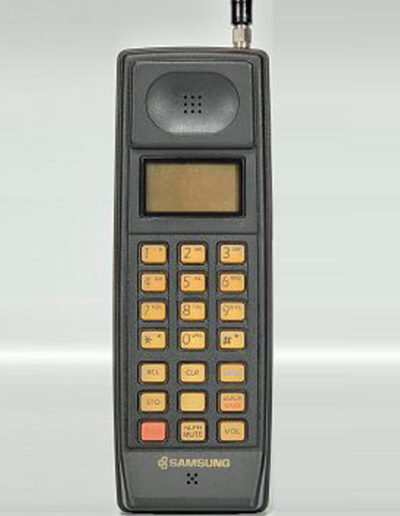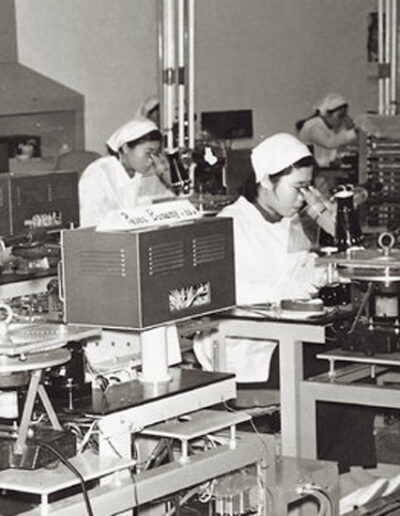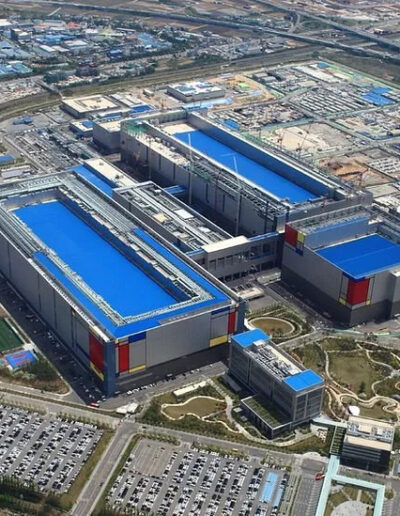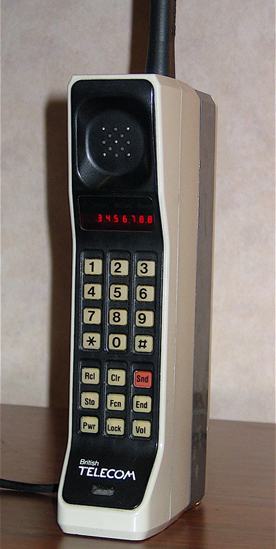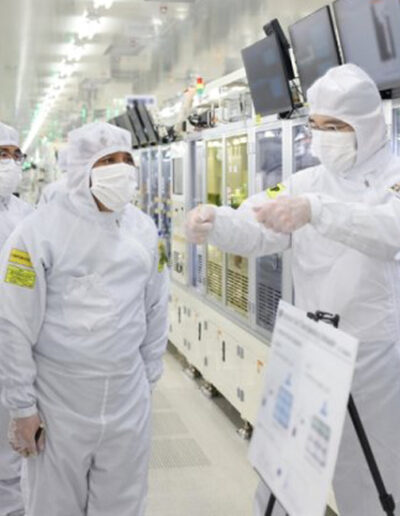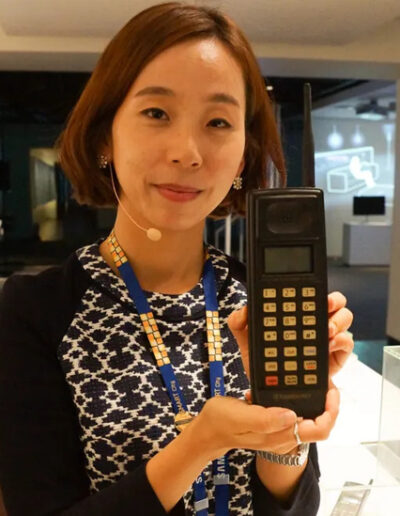The Samsung SH-100
1989
About the Object
Story of the Object
Teaching suggestions
Classroom Extras
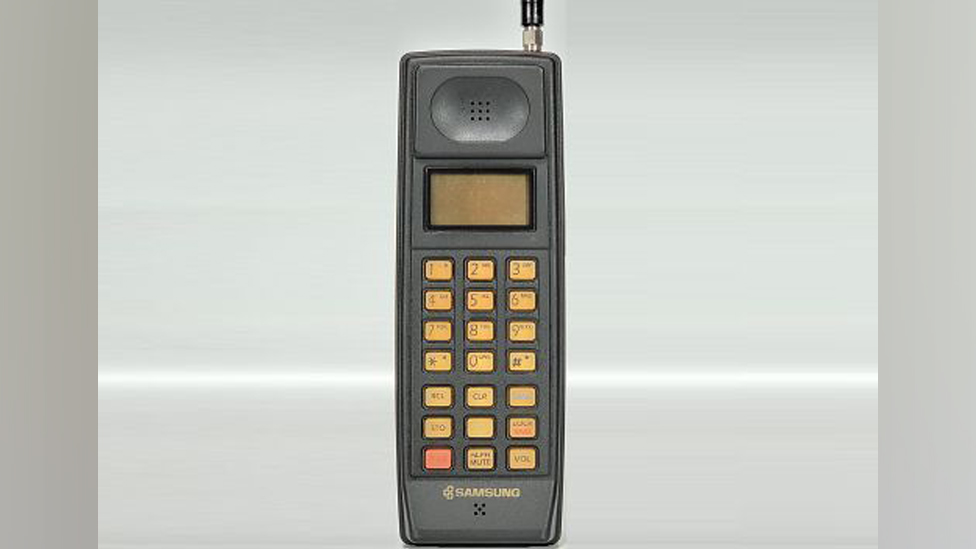
The Samsung SH-100
The SH-100 was Samsung’s first portable (or mobile) phone and it went on sale in 1989.
It was also the first hand-held phone made by a South Korean company.
Mobile phones were heavy and expensive at this time, and, as a result, Samsung sold only a few thousand of them.
However, the company was convinced that the mobile phone would become a key item in people’s lives. So, it persevered with producing new models.
Over the years, Samsung’s mobile phones have become very popular.
By 2012, one in every three smartphones sold globally was made by Samsung.
In recent years the market for mobile phone sales has become more competitive notably with the rise of Chinese firms such as Huawei.
However, Samsung is still an important producer of mobile phones and today approximately one in every five mobile phones sold is a Samsung.
The story of the SH-100 and Samsung’s rise to be one of the largest makers of mobile phones in the world demonstrates the inherent drive and ingenuity of the Korean people to create a highly successful electronics company producing goods which are useful, desirable and popular at home and abroad.
It also shows the confidence of the technology industry in Korea that it could create a world leading industry, perhaps best summarised by the slogan “Believe It Can Be Done”, which was used to market Samsung’s and Korea’s first flip phone, the SCH-6200 in 1999.
Background: The Impact of the Korean War
After the Korean War, the country was one of the poorest economies in the world.
However, by the twenty-first century, it had:
- created a powerful manufacturing base,
- become a member of the Organisation of Economic Cooperation and Development (the world club for advanced economies), and
- become home to some of the world’s leading industrial corporations.
The war between what became The Democratic People’s Republic of Korea (North Korea) and the Republic of Korea (South Korea) is explored in detail in Object: Statue of Brothers.
The fighting, which started with an invasion of the South by the North in 1950, lasted for three years.
On 27 July 1953 an Armistice was finally signed at Panmunjom which brought the fighting to an end.
Korea was divided into two states with the dividing line running along the 38th parallel or the 38th line of latitude on a world map.
Korea was now a divided peninsula and a divided nation.
Recovery and the ‘Miracle on the Han’
Over the years since that time, North and South Korea have followed very different paths.
South Korea has become a democratic state, and an economic and industrial force in Asia, welcoming foreign culture and ideas. It is a successful capitalist country, with large corporations exporting goods all over the world.
North Korea, on the other hand, is a communist country. Its economy is focused on supporting one of the world’s largest standing armies.
The North Korean nuclear weapons programme has created concerns across the world and has led to much criticism from world bodies like the United Nations.
The Korean War caused immense suffering and destruction across the Korean peninsula. It left upward of two million people dead and cities and towns were in ruin.
The governments of both North and South Korea had to set about rebuilding their respective countries.
Whereas the North made a quicker recovery, by 1961 the South was still a poor nation with only a modest rate of economic growth that was reliant on loans from the United States for its survival.
As a result of American assistance, thousands of Koreans benefitted from technical training and a constant flow of South Koreans travelled to the US to study such subjects as science, engineering, economics, and education.
This period also saw the emergence of entrepreneurs who would provide much talent to stimulate massive economic growth.
In the 1960s South Korea’s economy became dominated by ‘chaebol’, which were large business conglomerates – an organisation which is an amalgamation of many businesses.
Among the entrepreneurs that emerged in this period were:
– Chung Ju-yung, the founder of the engineering and motor manufacturing company Hyundai,
– Koo In-hwoi, the founder of the electronics giant LG,
– Kim Sung-kon, the founder of the engineering and cement manufacturing company SsangYong, and
– Lee Byung-chull, the most successful entrepreneur, whose various business interests merged to form the Samsung corporation.
The determination of these entrepreneurs combined with a skilled labour force, government encouragement and American support led to a period in the 1960s and 1970s when South Korea made rapid economic advances.
Heavy industry, including the car industry, benefited enormously from the South Korean government’s decision to promote the automotive industry as one of the key currency-earners for the country.
What followed was a period of huge economic growth and this improvement has been referred to as the “South Korean miracle” or “the miracle on the Han River”.
The Han River runs westwards in South Korea, passes through Seoul, and enters the Yellow Sea near the border with North Korea.
The description ‘miracle on the Han” has been used to mirror the economic recovery in West Germany after World War Two which has been referred to as the “miracle on the Rhine”.
The ambition of Chung Ju-yung and the creation of Hyundai
Lee Byung-chull was a South Korean entrepreneur. An entrepreneur is a person who sets up a business or businesses and is prepared to take on financial risks in the expectation of profit.
He founded the Samsung group of companies, which grew to become South Korea’s largest chaebolA chaebol is a conglomerate, or amalgamation, of a number of businesses, and has become regarded as one of South Korea’s most successful businessmen.
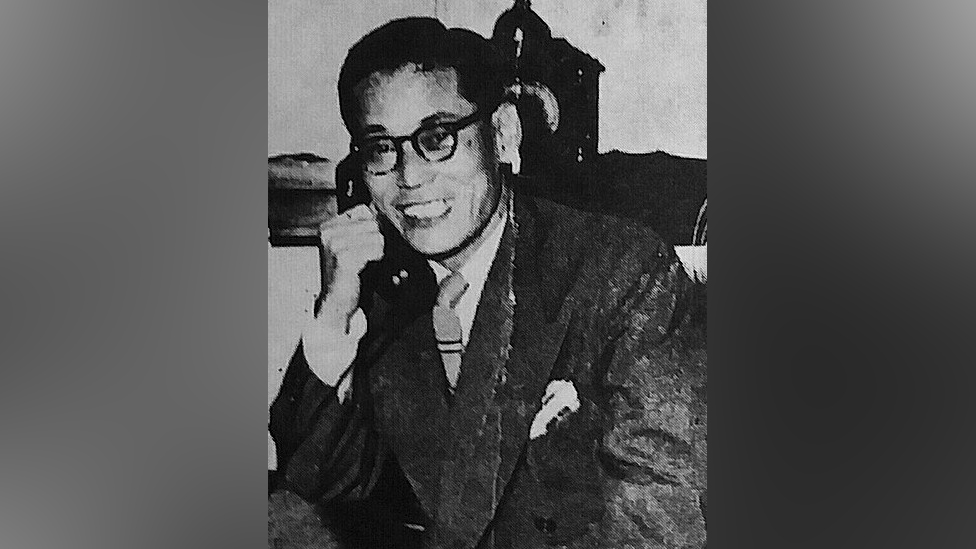
Lee Byung-chull
Lee Byung-chull was fascinated by business and in 1938 he established the Samsung Trading Company which exported fruits and vegetables collected around Daegu, along with dried fish bought from Pohang.
These items were exported to China and Manchuria.
Lee chose the name Samsung because of what it meant to Koreans and so what his products and services would provide for them as well.
‘Sam’ is the pronunciation of the Chinese character for “three” and is a favourite number among Koreans because it means large, plentiful, and strong.
“Sung” is the Korean pronunciation for the Chinese character meaning “star” and means bright, lofty, and eternally shining.
Lee chose the name Samsung, or Three Stars, to represent his desire for a business that would be large, strong, and eternally shining.
Keenly aware that the Korean economy lacked financial capital for investment and the workforce lacked technological skills, Lee concluded that the way forward was to focus upon international trade.
He moved his headquarters to Seoul, began exporting cuttlefish to such places as Hong Kong and Singapore and importing a diverse range of goods including cotton thread.
Within Korea the company also became involved with noodle production and brewing.
By the time of the outbreak of the Korean War in 1950, the Samsung Corporation, as it was then called, had become the leading company in Korea for domestic trade.
When North Korean troops invaded South Korea in 1950 Lee was obliged to move his business from Seoul to Busan in the south of the Korean peninsula.
Despite the disruption of war, he was able to turn this apparent catastrophe to his advantage.
This is because the arrival of UN and especially US troops and equipment into Busan gave him an opportunity to provide the support needed to help transport goods across Korea.
In addition, the Chosun Brewery in Daegu which had been purchased in 1939 unsurprisingly continued to do well during the War.
The brewery was also to play an unexpected role in Samsung’s recovery and expansion after the War.
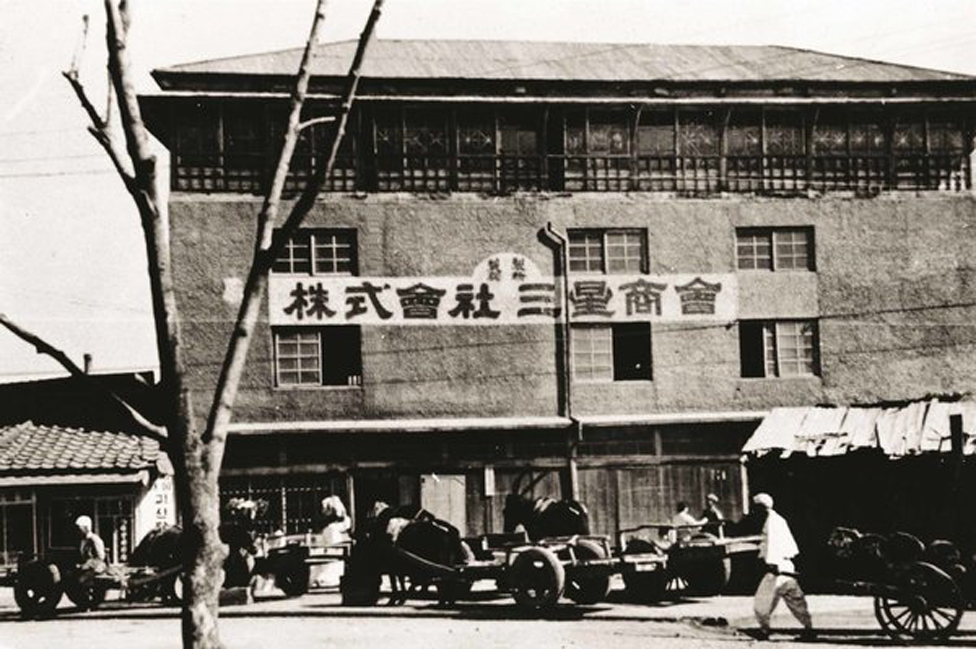
The exterior of the trading company’s office in Daegu, Korea (c1938)
Following the conclusion of the Korean War, Lee was determined that Samsung would become a major company with a range of interests.
He was convinced that success would come through expansion and diversification and by 1947 it was one of the largest trading companies in Korea.
He was also committed to replacing imports with domestic production.
For example, to help achieve this, he established in the early 1950s the Cheil Sugar Co. Ltd.
In 1953, Korea was entirely dependent on imports for refined sugar.
However, over the next three years, domestic sugar refining expanded and by 1956 the proportion of imported refined sugar had fallen to 7%.
Encouraged by the success of these enterprises, Lee expanded his economic interests into such industries as textiles, insurance, and retail.
The company became involved in electronics in the late 1960s, and construction and shipbuilding in the mid-1970s.
It would be these three elements – electronics, construction and shipbuilding – which would be at the heart of its future economic growth.
Perhaps his most famous company, though, would be Samsung Electronics founded in 1969.
Lee placed such an emphasis upon creating a successful electronics industry because he believed that electronics above all others would help make South Korea a world leader amongst developed countries.
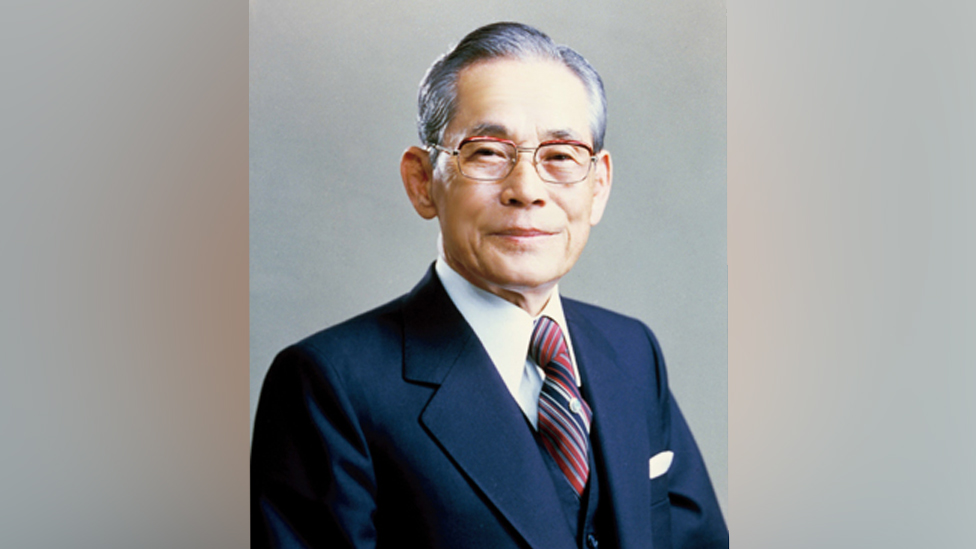
Lee Byung-chull (in later life)
Lee is regarded as Korea’s most successful entrepreneur in that he created the company which has come to be one of the world’s leading businesses.
He was committed to the idea of a business providing an economical contribution to the nation, that is that a business must provide a service for the nation.
This belief has served South Korea and Lee himself well.
In his later life he established the Samsung Culture Foundation (1969) to “promote a broad range of programmes to enrich Korean cultural life”.
After his death in 1987 (age 77), his collection of Korean art which had opened as a private museum – the Ho-Am Art Museum – in 1982 was able to be viewed by the public.
It is considered to be one of the most important art collections in the country not least because 27 items have been listed as National Treasures by the South Korean government.
Samsung – the company which rose from the ashes.
The Chosun Brewery proved to be a popular and successful investment for Samsung Trading.
It produced soju, which was refined rice wine, raw rice wine and cider.
However, soon after the Korean War broke out, the company suffered from thefts of its imported goods stored in warehouses in Daegu.
Nevertheless, the arrival of refugees and soldiers saw an increase in the demand for its goods and the brewery became extremely busy.
With the advance of North Korean troops closer to Daegu, though, it was decided to hide the company’s cash.
The story is told that the money was entrusted to an alcohol wholesaler in Busan and two wooden boxes containing the cash hidden beneath documents were despatched by car to him.
In all cash worth 300 million Korean won was sent in the boxes. This would be worth about £60 million today.
Unfortunately, the car went missing on its way to Busan and, because of the disruption caused by the war, the search for the car and the money could not be undertaken.
The story continues that about a month later, the driver of the car reappeared and explained that he hid the boxes of cash in a rice mill on the street of Yeong-cheon which was located on the way to Busan.
He also said that he had not been able to tell anyone because he was called up to serve in the South Korean forces.
When the driver and representatives of the brewery went to search for the boxes, they found that the mill had been destroyed by fire.
However, and to their great astonishment, they found the wooden boxes amongst the ashes.
Surprisingly, the cash had not been damaged.
As a result, Lee, who had lost much of his wealth during the Korean War, now had a considerable sum of money on which he could re-establish the Samsung Corporation.
The SH-100 – South Korea’s first portable, or mobile, phone.
With the creation of Samsung Electronics in 1969, the company set out to become a world leader in all aspects of the electronics industry.
The electronics business was a completely new field for Samsung, and for any company in South Korea, and so it had little knowledge or experience.
Nevertheless, Lee appreciated that electronics would be an effective way to help South Korea become a modern state.
To help fill the knowledge gap, Samsung began a series of joint ventures with Sanyo, a Japanese electronics manufacturing company.
The two companies cooperated on producing electronic and electrical appliances including televisions, calculators, refrigerators, air conditioners, and washing machines.
Such was the success of these enterprises that by 1981, for example, Samsung had produced and sold over 10 million black and white televisions.
The process of expansion led Samsung to manufacture a wider range of goods and in the 1980s it started to sell personal computers and mobile phones.
The concept of a portable phone was not new in the 1980s.
Its origins are to be found in a type of mobile phone which was used by train operators to communicate with trains.
However, it was during World War Two that the portable phone really became important.
The Allies used over 130,000 portable phones known as the SCR-536 Handie-Talkie.
It helped troops in the field communicate with each other.
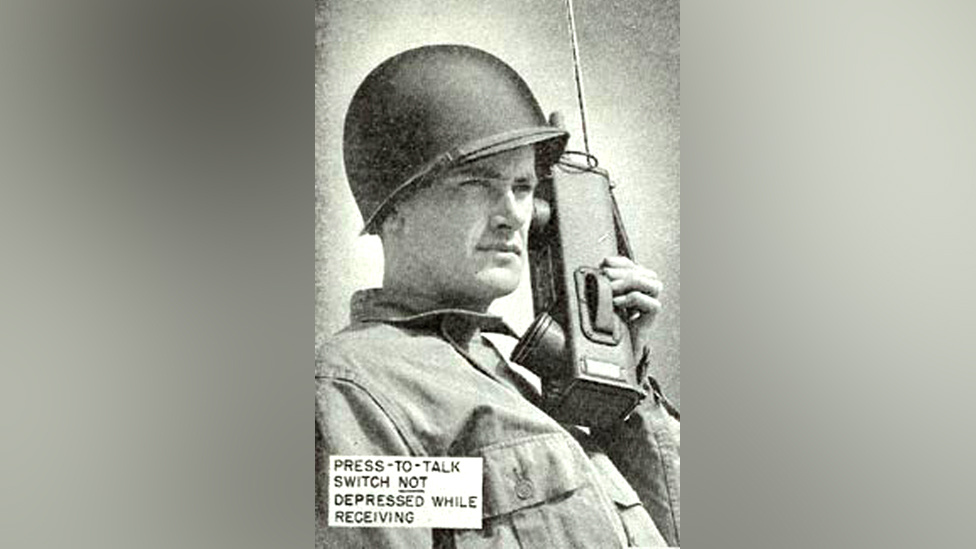
Handie-Talkie
However, what was essentially a two-way radio receiver had a short battery life and an equally disappointing range of about one mile.
Nevertheless, it worked – and the company which produced it went on to become Motorola, one of the world’s leading phone producers.
After the end of the war, mobile phone technology developed with the production of car phones.
The first one was launched in America in 1946.
However, it was very heavy at 36kgs, could only be used in major American cities and on specific roads.
It was also very expensive.
Nevertheless, during the 1950s and 1960s the phones were popular especially amongst business executives and wealthy people.
Following years of research and development, the world’s first prototype mobile phone was eventually launched by Motorola.
It was not a phone which could yet be sold to the general public and it took Motorola a further ten years and $100 million to develop a final version which could go on sale.
When it was launched, the DynaTAC 8000X was nearly 30cms long and weighed over a kilogram. It was also immensely expensive at $4,000.
Nevertheless, anyone could buy one and people did with Motorola stating that it found it difficult to keep up with demand.
The potential of the mobile phone was now realised around the world and other companies soon produced their versions, with Nokia developing its first mobile phone in 1987.
In 1984 Korea’s first mobile phone was introduced but the home market was dominated by Motorola which was the world’s leading mobile communications company.
Mobile phones did not sell well in South Korea and this was due to a number of factors.
For example, the physical geography of the Korean peninsula, especially the large number of mountains and the fact that most people lived in the valleys, meant that ensuring high-quality phone communication across the country was an immense challenge.
In addition, people complained that the service, especially the quality of speech, was just not good enough.
In response, Samsung tried to develop a phone which would work effectively in Korea despite the geographical barriers.
In this it was successful and in 1989 it launched the Samsung SH-100.
The year before the launch, South Korea had hosted the Olympic Games.
Based principally in Seoul, the games were a great success.
As the host country, South Korea won 12 gold medals and 33 medals in total, making it the fourth most successful nation out of 159 which participated in the 237 events.
More than this was the pride the games brought for the South Korean people.
The games were in effect a highly symbolic event which raised the status and reputation of the country across the world.
For some commentators, the Olympics of 1988 were the culmination of the Miracle on the Han because they highlighted the country’s successful rejuvenation following the destruction of the Korean War.
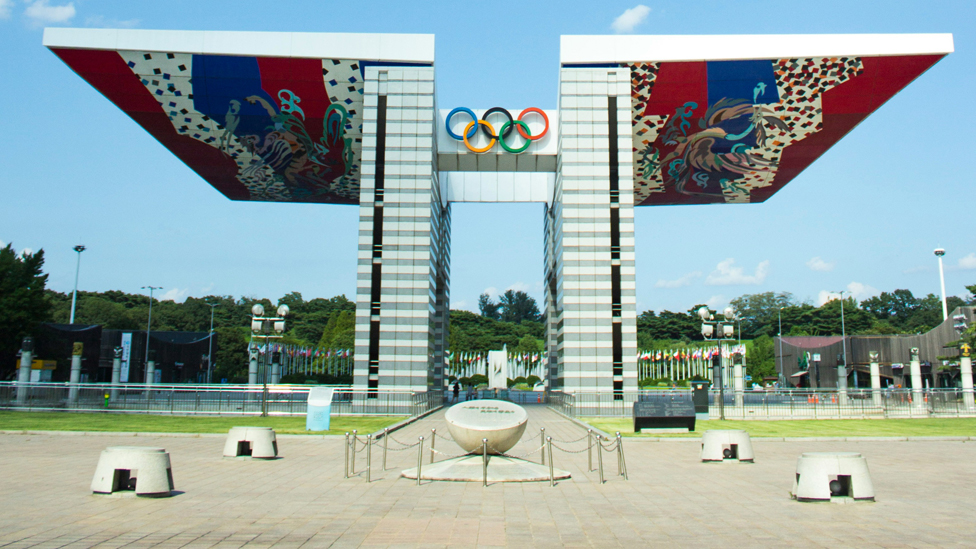
The Olympic Games were held in Seoul in 1988
Samsung decided that the Seoul Olympic Games offered an ideal opportunity to test the phone and demonstrate its success as an electronics company and display the vitality of business and manufacturing in South Korea.
As a result, the SH-100 was tested and showcased at the games.
Forty-eight phones were handed out, one to each of the members of the International Olympic Committee including the president, Juan Samaranch.
The phones appear to have worked well and so in the following year, 1989, the SH-100 went on sale in South Korea.
It was smaller and lighter than the Motorola equivalent, but it was still somewhat heavy, weighing in at 700 grams.
However, because of the high price, mobile phones were seen as luxury goods at the time.
This meant that Samsung only sold a few thousand phones. In 1992, it sold 20,000 units which amounted to 12% of the share of the home market.
Nevertheless, Samsung was now the second largest seller of mobile phones in South Korea, behind the American giant Motorola.
| Samsung SH-100 | iPhone | Samsung S23 | |
| Size | Height 199mm Width 69mm Depth 46mm |
147.6mm 71.6mm 7.8mm |
146.3mm 70.9mm 7.6mm |
| Weight | 700g | 171g | 168g |
The significance of the SH-100
The successful launch of the SH-100 as South Korea’s first mobile phone provided a platform for further research and development.
During the 1990s and early 2000s Samsung launched a series of new models which brought success for the company, becoming the market leader for mobile phones in South Korea.
Design improvements led to better speech quality, better connectivity across the country, and lighter and smaller phones which were, therefore, easier to handle, all of which made Samsung phones more attractive to the general public.
In 1995, for example, it produced the SH-770, the Anycall.
Marketing was key and this phone was advertised with such slogans as “Anytime, Anywhere” and “Strong in the Korean environment”.
The name ‘Anycall’ was chosen to imply strength.
Samsung has been at the forefront of innovation for mobile phones.
In 1996, the SCH-100 was launched, the world’s first Coda Division Multiple Access, or CDMA, mobile phone which in time enabled messaging and the transmission of images to be possible.
Three years later, it produced the SCH-6200, South Korea’s first flip phone and it was cleverly marketed under the slogan “Believe it can be done”.
The SCH-M210, launched in 1999, was the world’s first phone to have an MP3 playback facility, a feature which is common on mobiles today.
The SCH-M220, launched in 2002, entered the Guinness Book of Records as the world’s first television phone.
The SCH-S230, launched in 2004, was the world’s first 3-megapixel camera phone combining a high-resolution camera with a mobile phone.
Samsung mobiles gradually became more popular within South Korea.
In 1995 the ‘Anycall’ phone took over 51% of the market share within South Korea, thus making Samsung the leading phone producer within that country.
The SCH-X430, launched in 2002, was Samsung’s’ first phone to sell 10 million units, and the SGH-D500, launched in 2005, sold 1 million units in its first month on the market.
Samsung phones have also become more popular across the world.
In 2012, one in every three smartphones sold globally was made by Samsung.
However, stiff competition from Chinese brands like HUAWEI and Xiaomi has led to Samsung selling less phones worldwide.
In March 2023 Samsung was calculated to account for approximately 21% of global smartphone shipments.
Samsung realised that the key to success was to stay ahead of the market and to match and hopefully beat its rivals.
As a result, when Apple produced the iPhone brand, Samsung responded with its Galaxy brand.
With the development of better cameras, fashionable designs and a range of features, the mobile phone was no longer just a phone.
The smartphone had become a must-have accessory and an icon for the modern age.
Samsung has played a leading role in the development of the mobile phone, and it has helped Samsung Electronics to become one of the major world leaders in the production of smartphones.
It is also a global super company in the manufacture and sale of electronic and electrical goods.
Despite the high price and relatively low sales of the SH-100, Samsung appreciated that the mobile phone market was a financial winner for the company, a successful business for the South Korean economy and an asset for the Korean people.
As a result, mobile phone development was a major focus of the company, and it has established itself as a world leader with a reputation for high quality products.
In many ways, the rise of Samsung epitomises the recovery of South Korea after the devastation of the Korean War – both sprung to life from ashes!
In addition, the development of the SH-100 demonstrates clearly the ability of South Korean entrepreneurs and companies to adapt to changing circumstances, adopt new industries, strive to make those businesses successful, train the workforce accordingly, market the products effectively and innovate to survive.
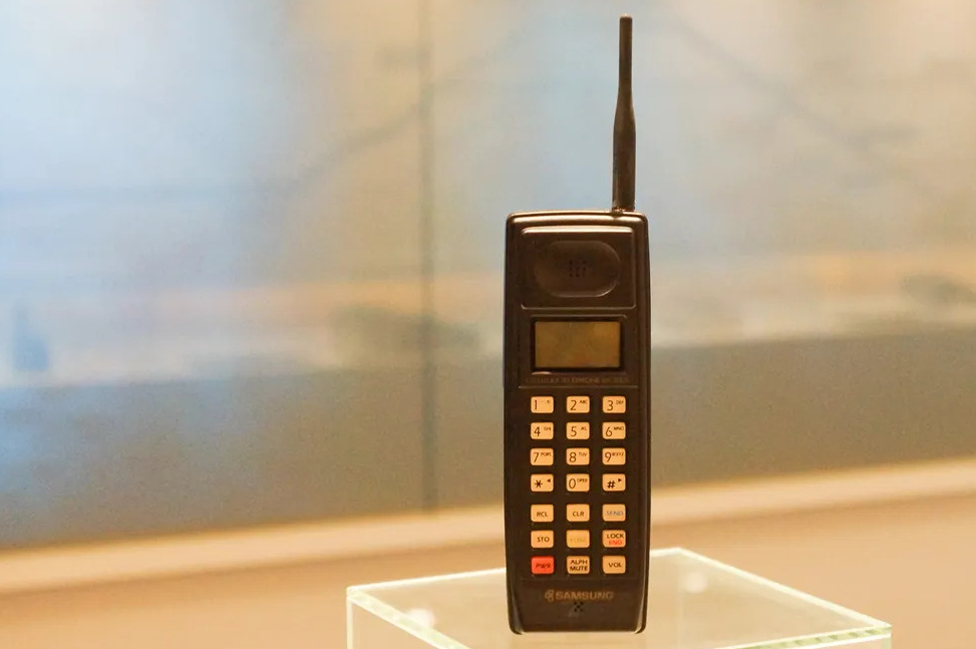
The Samsung SH-100
The slogan used to market the SCH-6200 in 1999 summarises well the commitment, determination and ambition of both Samsung and South Korea in the second half of the 20th Century, namely “Believe It Can Be Done”.
Retrieval practice
Why not create some short multi-choice quizzes to test what students can recall about the content they have just learned about? Create a quick test of 8, 10, 12 or 20 questions. Here are three examples:
1. What was the name of Samsung’s first portable (or mobile) phone?
a) SH-100
b) SP-100
c) SCH-6200
2. In what year did Samsung’s first portable (or mobile) phone go on sale?
a) 1979
b) 1989
c) 1999
3. What was the name of the successful entrepreneur, whose various business interests merged to form the Samsung corporation?
a) Kim Sung Kon
b) Lee Byung-chull
c) The Turin Motor Show
Telephone History
Ask students to research the history of telephones. This could be an individual or group project. It could be presented as a fact-file or PowerPoint presentation. Perhaps give students this structure:
- Who is credited as the inventor of the telephone?
- How does a traditional telephone work?
- Facts about traditional phones
- How does a mobile/cell phone work?
- Facts about mobile/cell phones
TELEPHONE Timeline
Ask students to look for key dates in the history of telephone and telecommunications. Then create a timeline that records what happens on each of the dates.
A few early key dates in telephone history might include:
1672: The first “acoustic telephone” is made by Robert Hooke. He found that sound could travel along a wire or string.
1838: Morse code is invented by Samuel B Morse. He found that you could send messages by pressing and releasing a button in intervals. This transmitted a pattern of sounds.
1858: The first transatlantic telephone cable was laid. This connected the US and Britain by telegraph.
1876: Alexander Graham Bell invents the telephone.
1927: The first transatlantic phone call is made from the USA to Britain. These were radio phones.
What was going on in the world?
To help place this object into context it’s a good idea to ask your pupils to find out what else was going on in the world in that year. It could be argued that 1989 was a particularly significant year in world history.
Therefore, the SH-100 could be used as a window looking into these wider events. Pupils could work individually or in groups and investigate three, five, or even seven different key events from 1989.
Pupils could focus on what happened and the significance of the event.
Some of the things that you could get them to focus on are:
- The Tiananmen Square Protests and Massacre in China
- The Hillsborough Disaster in England
- Nintendo release the Game Boy in Japan and the USA
- The Berlin Wall comes down ending the split between East and West Germany
- The Velvet Revolution in Czechoslovakia
A Samsung Fact file
The history of Samsung tracks the “economic miracle of the Han River” which saw South Korea’s rapid economic growth following the end of the Korean War.
It is interesting to note that Samsung started out as company exporting fruit, vegetables and dried fish to China and Manchuria and then its founder, Lee realised that diversification was the route to success and financial gain.
- Pupils could investigate the different stages of Samsung’s development under the title ‘from fruit and fish to electronics.’ Encourage them to consider several different industries that Lee invested in and how the labour force changed and became increasingly skilled.
- They could focus on Lee Byung-chull, the founder of Samsung and create a timeline of his life. You could get them to use the headings: Early Life, Career, Cultural Interests.
A History of Logos
The Samsung logo is now famous across the globe.
Logos in general are a powerful asset for any industry as they act as symbol that customers recognise and associate with a particular brand.
They also break across the language barrier and, if a company is really successful are recognisable across the globe. You only have to think of the Apple logo, the Nike Swoosh or the McDonald’s Golden Arches to recognise this.
But symbols or logos are not just modern inventions. They have a long and fascinating history going back to the ancient world and then through to the Medieval period and beyond.
You could get your pupils to investigate this topic. They could work in groups, pairs or individually looking at several areas including: the Ancient Foundations, Heraldic Symbolism, The influence of Printing, Creative Design and the Digital Age.
Classroom Extras
Here you will find a number of images, video clips and website links which can be used as extras for teaching in the classroom or for use by pupils undertaking independent research.
Images
Employees on a production line at the company’s plant in Suwon, South Korea (circa 1969) © New York Times
A Motorola DynaTAC 8000X from 1984. This phone has an early British Telecom badge and primitive red LED display
Map
Select Google Maps options to view key locations for different objects:
Videos

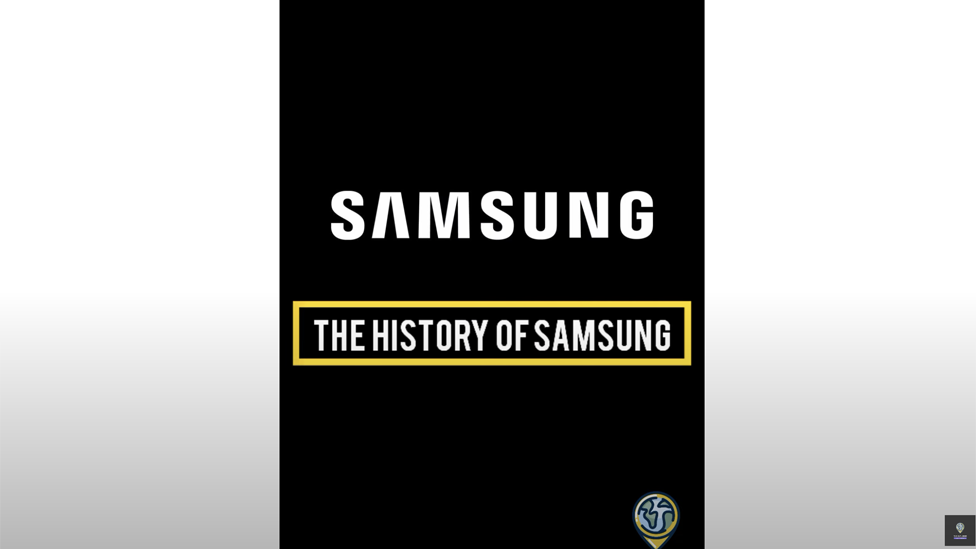 First Samsung Mobile Phone Samsung SH -100 (Link opens in YouTube)
First Samsung Mobile Phone Samsung SH -100 (Link opens in YouTube)
Discover more online
Wikipedia: The Story of Samsung
Wikipedia: Samsung Electronics
Wikipedia: The founder of Samsung
Wikipedia: The Story of the mobile phone
Samsung: The History of Samsung
Hoam Foundation: Lee Byung-chull’s Foundation
Android Authority: What was the first Samsung cell phone ever? Take a look!
Android Authority: The history of cell phones: A decade-by-decade timeline
Android Authority: 15 crazy old phones from a Korean museum
Teaching Korea is not responsible for the content of external websites
Share to Google Classroom

